MOD002634 Materials and Processes Report: Engineering Applications
VerifiedAdded on 2022/07/27
|29
|3281
|23
Report
AI Summary
This report delves into the realm of materials and processes, commencing with an exploration of composite materials. It examines their evolution, types like fiber-reinforced plastics and metal matrix composites (MMCs), applications in diverse industries (automotive, leisure), advantages (weight reduction, high strength-to-weight ratio), and disadvantages. The report also covers manufacturing methods such as squeeze-casting and powder metallurgy, alongside maintenance and recyclability considerations. The second part of the report focuses on welded and brazed specimens, analyzing various welding techniques (fusion, solid phase) and identifying potential faults like porosity, discussing the metallurgical effects of these processes. The final section addresses material failures, presenting case studies of component failures (cast aluminium collet, stainless steel pipes, cam shafts, and gears), identifying causes (corrosion, wear, fatigue) and suggesting remedial measures. The report concludes with a description of corrosion, its types and its effects.
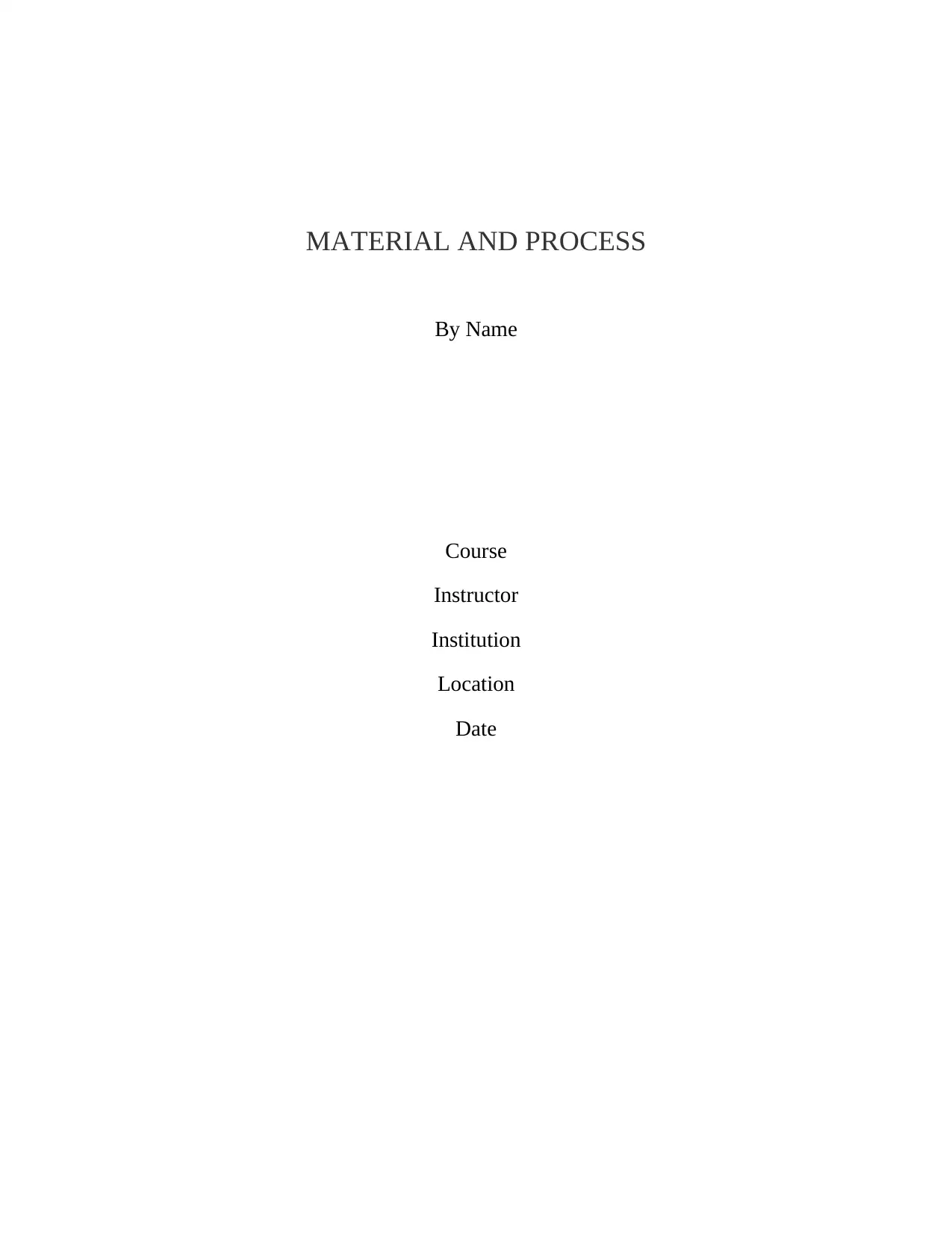
MATERIAL AND PROCESS
By Name
Course
Instructor
Institution
Location
Date
By Name
Course
Instructor
Institution
Location
Date
Paraphrase This Document
Need a fresh take? Get an instant paraphrase of this document with our AI Paraphraser
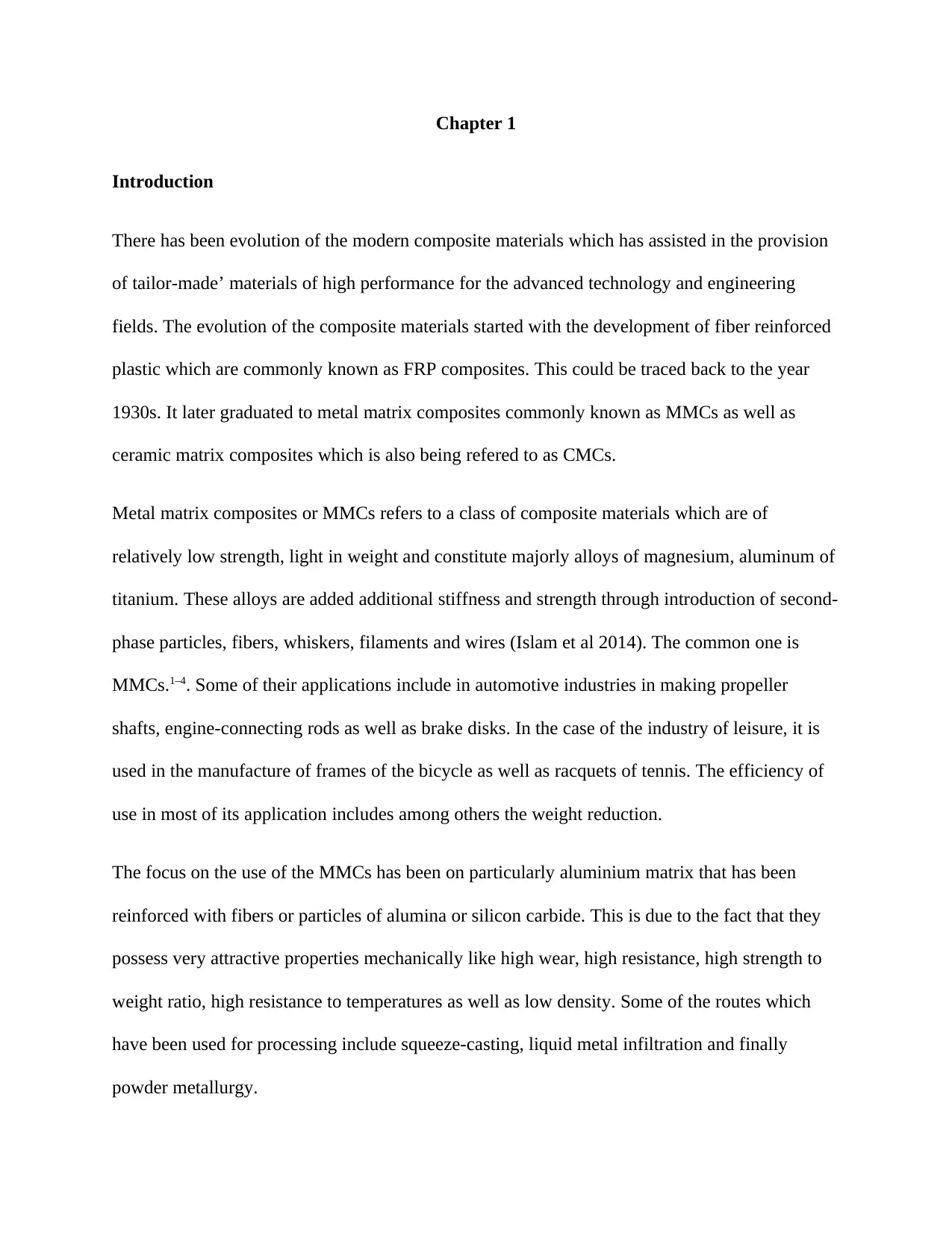
Chapter 1
Introduction
There has been evolution of the modern composite materials which has assisted in the provision
of tailor-made’ materials of high performance for the advanced technology and engineering
fields. The evolution of the composite materials started with the development of fiber reinforced
plastic which are commonly known as FRP composites. This could be traced back to the year
1930s. It later graduated to metal matrix composites commonly known as MMCs as well as
ceramic matrix composites which is also being refered to as CMCs.
Metal matrix composites or MMCs refers to a class of composite materials which are of
relatively low strength, light in weight and constitute majorly alloys of magnesium, aluminum of
titanium. These alloys are added additional stiffness and strength through introduction of second-
phase particles, fibers, whiskers, filaments and wires (Islam et al 2014). The common one is
MMCs.1–4. Some of their applications include in automotive industries in making propeller
shafts, engine-connecting rods as well as brake disks. In the case of the industry of leisure, it is
used in the manufacture of frames of the bicycle as well as racquets of tennis. The efficiency of
use in most of its application includes among others the weight reduction.
The focus on the use of the MMCs has been on particularly aluminium matrix that has been
reinforced with fibers or particles of alumina or silicon carbide. This is due to the fact that they
possess very attractive properties mechanically like high wear, high resistance, high strength to
weight ratio, high resistance to temperatures as well as low density. Some of the routes which
have been used for processing include squeeze-casting, liquid metal infiltration and finally
powder metallurgy.
Introduction
There has been evolution of the modern composite materials which has assisted in the provision
of tailor-made’ materials of high performance for the advanced technology and engineering
fields. The evolution of the composite materials started with the development of fiber reinforced
plastic which are commonly known as FRP composites. This could be traced back to the year
1930s. It later graduated to metal matrix composites commonly known as MMCs as well as
ceramic matrix composites which is also being refered to as CMCs.
Metal matrix composites or MMCs refers to a class of composite materials which are of
relatively low strength, light in weight and constitute majorly alloys of magnesium, aluminum of
titanium. These alloys are added additional stiffness and strength through introduction of second-
phase particles, fibers, whiskers, filaments and wires (Islam et al 2014). The common one is
MMCs.1–4. Some of their applications include in automotive industries in making propeller
shafts, engine-connecting rods as well as brake disks. In the case of the industry of leisure, it is
used in the manufacture of frames of the bicycle as well as racquets of tennis. The efficiency of
use in most of its application includes among others the weight reduction.
The focus on the use of the MMCs has been on particularly aluminium matrix that has been
reinforced with fibers or particles of alumina or silicon carbide. This is due to the fact that they
possess very attractive properties mechanically like high wear, high resistance, high strength to
weight ratio, high resistance to temperatures as well as low density. Some of the routes which
have been used for processing include squeeze-casting, liquid metal infiltration and finally
powder metallurgy.
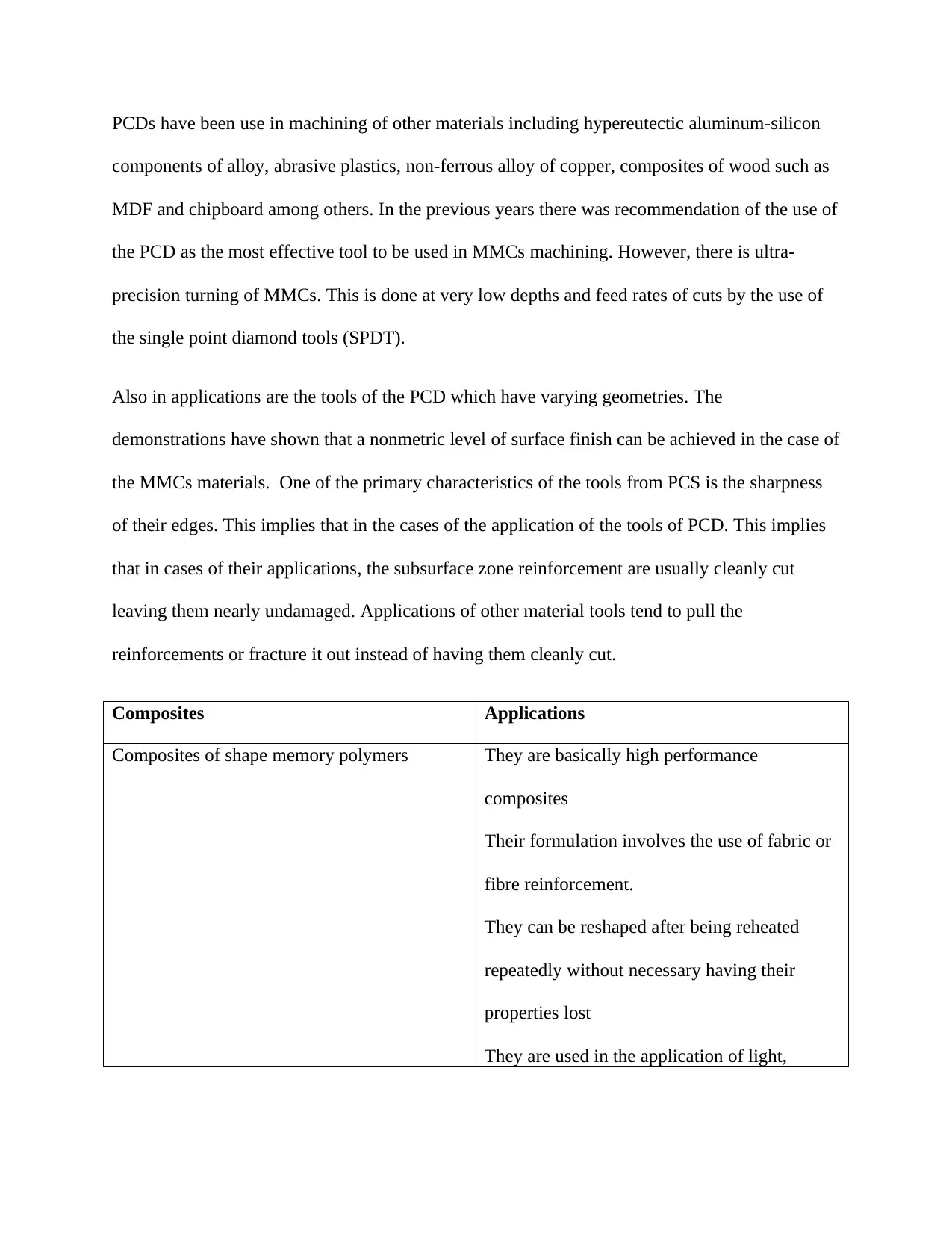
PCDs have been use in machining of other materials including hypereutectic aluminum-silicon
components of alloy, abrasive plastics, non-ferrous alloy of copper, composites of wood such as
MDF and chipboard among others. In the previous years there was recommendation of the use of
the PCD as the most effective tool to be used in MMCs machining. However, there is ultra-
precision turning of MMCs. This is done at very low depths and feed rates of cuts by the use of
the single point diamond tools (SPDT).
Also in applications are the tools of the PCD which have varying geometries. The
demonstrations have shown that a nonmetric level of surface finish can be achieved in the case of
the MMCs materials. One of the primary characteristics of the tools from PCS is the sharpness
of their edges. This implies that in the cases of the application of the tools of PCD. This implies
that in cases of their applications, the subsurface zone reinforcement are usually cleanly cut
leaving them nearly undamaged. Applications of other material tools tend to pull the
reinforcements or fracture it out instead of having them cleanly cut.
Composites Applications
Composites of shape memory polymers They are basically high performance
composites
Their formulation involves the use of fabric or
fibre reinforcement.
They can be reshaped after being reheated
repeatedly without necessary having their
properties lost
They are used in the application of light,
components of alloy, abrasive plastics, non-ferrous alloy of copper, composites of wood such as
MDF and chipboard among others. In the previous years there was recommendation of the use of
the PCD as the most effective tool to be used in MMCs machining. However, there is ultra-
precision turning of MMCs. This is done at very low depths and feed rates of cuts by the use of
the single point diamond tools (SPDT).
Also in applications are the tools of the PCD which have varying geometries. The
demonstrations have shown that a nonmetric level of surface finish can be achieved in the case of
the MMCs materials. One of the primary characteristics of the tools from PCS is the sharpness
of their edges. This implies that in the cases of the application of the tools of PCD. This implies
that in cases of their applications, the subsurface zone reinforcement are usually cleanly cut
leaving them nearly undamaged. Applications of other material tools tend to pull the
reinforcements or fracture it out instead of having them cleanly cut.
Composites Applications
Composites of shape memory polymers They are basically high performance
composites
Their formulation involves the use of fabric or
fibre reinforcement.
They can be reshaped after being reheated
repeatedly without necessary having their
properties lost
They are used in the application of light,
⊘ This is a preview!⊘
Do you want full access?
Subscribe today to unlock all pages.

Trusted by 1+ million students worldwide
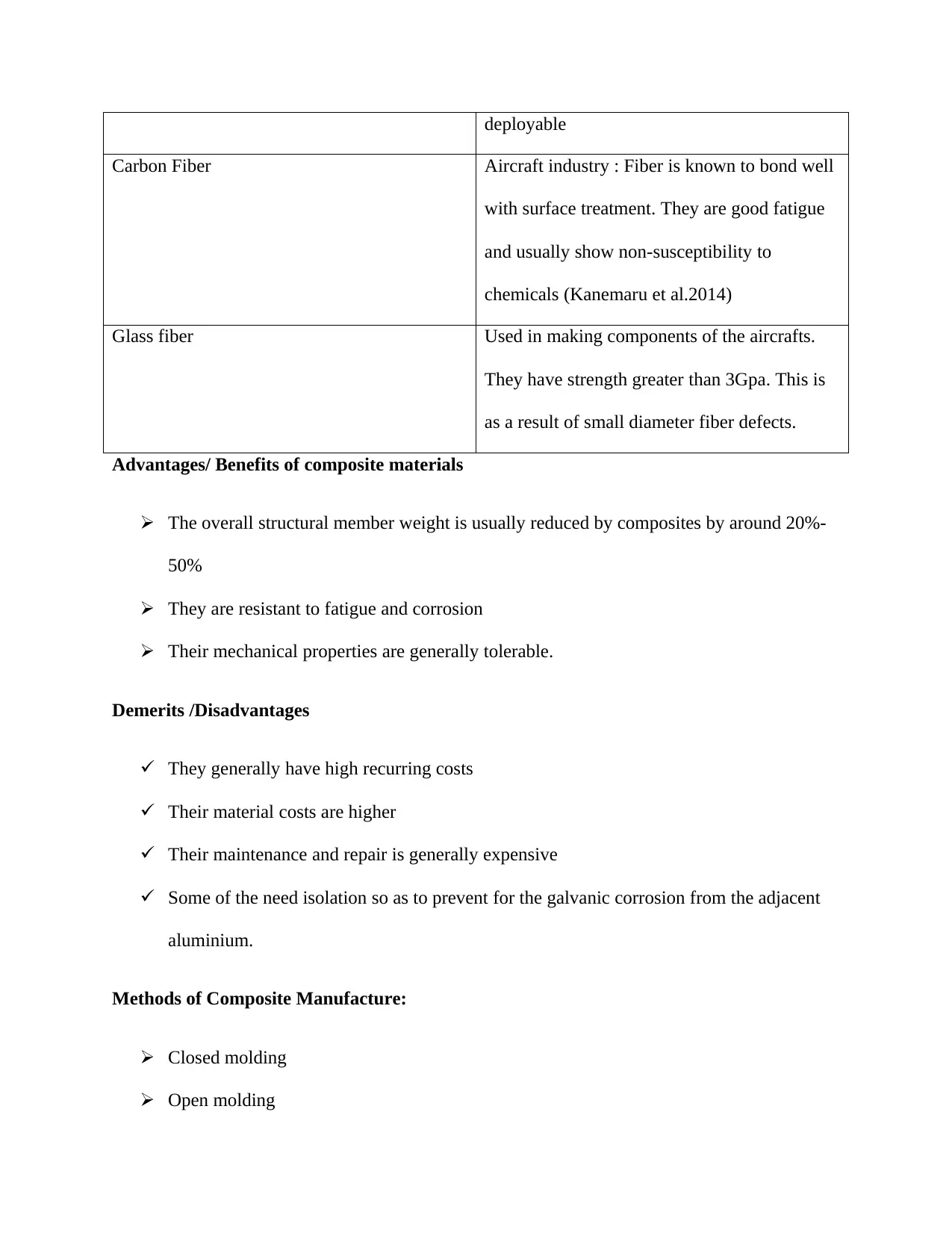
deployable
Carbon Fiber Aircraft industry : Fiber is known to bond well
with surface treatment. They are good fatigue
and usually show non-susceptibility to
chemicals (Kanemaru et al.2014)
Glass fiber Used in making components of the aircrafts.
They have strength greater than 3Gpa. This is
as a result of small diameter fiber defects.
Advantages/ Benefits of composite materials
The overall structural member weight is usually reduced by composites by around 20%-
50%
They are resistant to fatigue and corrosion
Their mechanical properties are generally tolerable.
Demerits /Disadvantages
They generally have high recurring costs
Their material costs are higher
Their maintenance and repair is generally expensive
Some of the need isolation so as to prevent for the galvanic corrosion from the adjacent
aluminium.
Methods of Composite Manufacture:
Closed molding
Open molding
Carbon Fiber Aircraft industry : Fiber is known to bond well
with surface treatment. They are good fatigue
and usually show non-susceptibility to
chemicals (Kanemaru et al.2014)
Glass fiber Used in making components of the aircrafts.
They have strength greater than 3Gpa. This is
as a result of small diameter fiber defects.
Advantages/ Benefits of composite materials
The overall structural member weight is usually reduced by composites by around 20%-
50%
They are resistant to fatigue and corrosion
Their mechanical properties are generally tolerable.
Demerits /Disadvantages
They generally have high recurring costs
Their material costs are higher
Their maintenance and repair is generally expensive
Some of the need isolation so as to prevent for the galvanic corrosion from the adjacent
aluminium.
Methods of Composite Manufacture:
Closed molding
Open molding
Paraphrase This Document
Need a fresh take? Get an instant paraphrase of this document with our AI Paraphraser
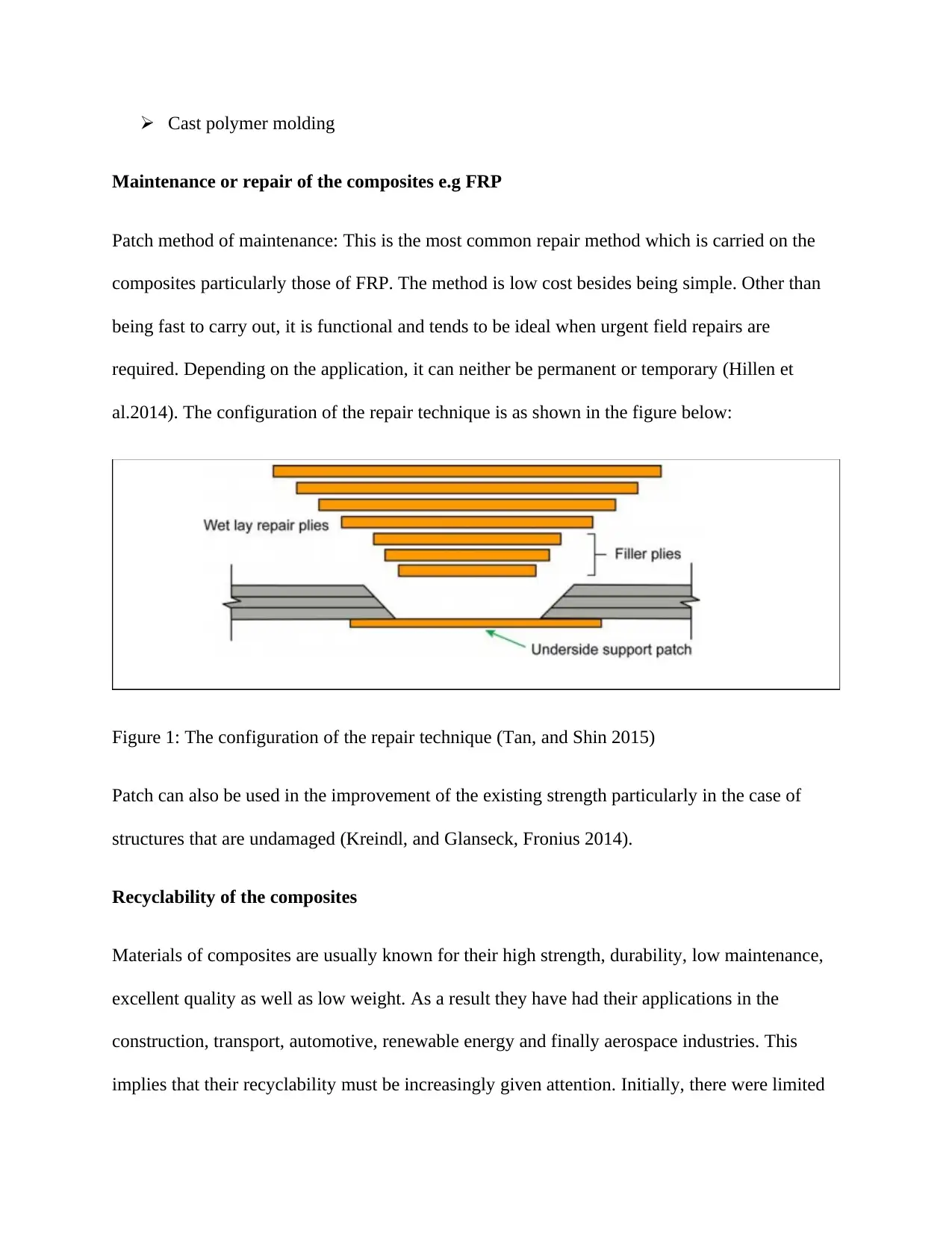
Cast polymer molding
Maintenance or repair of the composites e.g FRP
Patch method of maintenance: This is the most common repair method which is carried on the
composites particularly those of FRP. The method is low cost besides being simple. Other than
being fast to carry out, it is functional and tends to be ideal when urgent field repairs are
required. Depending on the application, it can neither be permanent or temporary (Hillen et
al.2014). The configuration of the repair technique is as shown in the figure below:
Figure 1: The configuration of the repair technique (Tan, and Shin 2015)
Patch can also be used in the improvement of the existing strength particularly in the case of
structures that are undamaged (Kreindl, and Glanseck, Fronius 2014).
Recyclability of the composites
Materials of composites are usually known for their high strength, durability, low maintenance,
excellent quality as well as low weight. As a result they have had their applications in the
construction, transport, automotive, renewable energy and finally aerospace industries. This
implies that their recyclability must be increasingly given attention. Initially, there were limited
Maintenance or repair of the composites e.g FRP
Patch method of maintenance: This is the most common repair method which is carried on the
composites particularly those of FRP. The method is low cost besides being simple. Other than
being fast to carry out, it is functional and tends to be ideal when urgent field repairs are
required. Depending on the application, it can neither be permanent or temporary (Hillen et
al.2014). The configuration of the repair technique is as shown in the figure below:
Figure 1: The configuration of the repair technique (Tan, and Shin 2015)
Patch can also be used in the improvement of the existing strength particularly in the case of
structures that are undamaged (Kreindl, and Glanseck, Fronius 2014).
Recyclability of the composites
Materials of composites are usually known for their high strength, durability, low maintenance,
excellent quality as well as low weight. As a result they have had their applications in the
construction, transport, automotive, renewable energy and finally aerospace industries. This
implies that their recyclability must be increasingly given attention. Initially, there were limited

operations of commercial recyclability in the case of mainstream materials of composites as a
result of technological as well as economic constraints. However, with the rise of the R&D
activities, composites can be recycled through reheating and reshaping.
Chapter 2
Part one
Figure 2: Specimens Single pass arc weld in plain low carbon steel
Figure 3: Low carbon steel arc weld.
result of technological as well as economic constraints. However, with the rise of the R&D
activities, composites can be recycled through reheating and reshaping.
Chapter 2
Part one
Figure 2: Specimens Single pass arc weld in plain low carbon steel
Figure 3: Low carbon steel arc weld.
⊘ This is a preview!⊘
Do you want full access?
Subscribe today to unlock all pages.

Trusted by 1+ million students worldwide
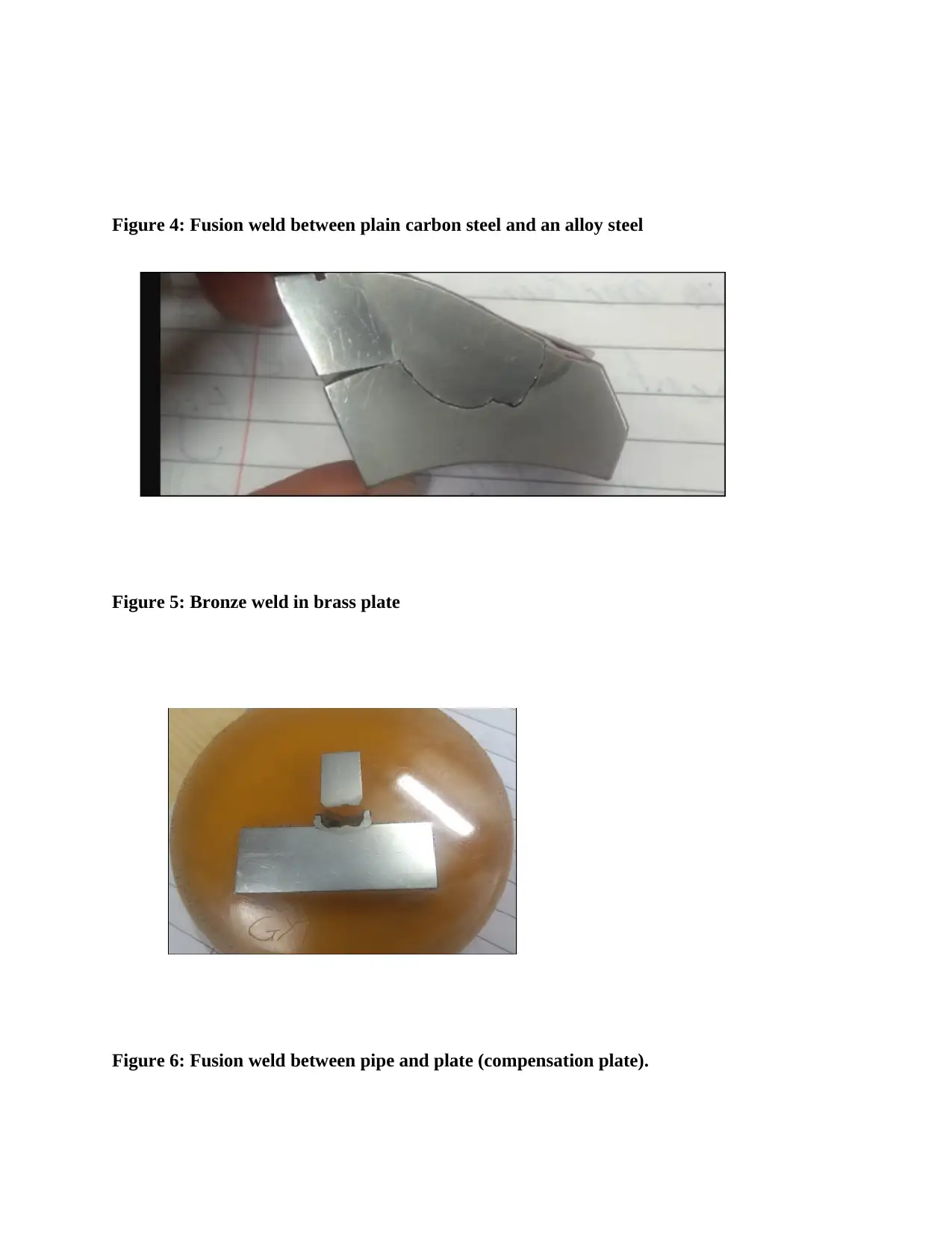
Figure 4: Fusion weld between plain carbon steel and an alloy steel
Figure 5: Bronze weld in brass plate
Figure 6: Fusion weld between pipe and plate (compensation plate).
Figure 5: Bronze weld in brass plate
Figure 6: Fusion weld between pipe and plate (compensation plate).
Paraphrase This Document
Need a fresh take? Get an instant paraphrase of this document with our AI Paraphraser
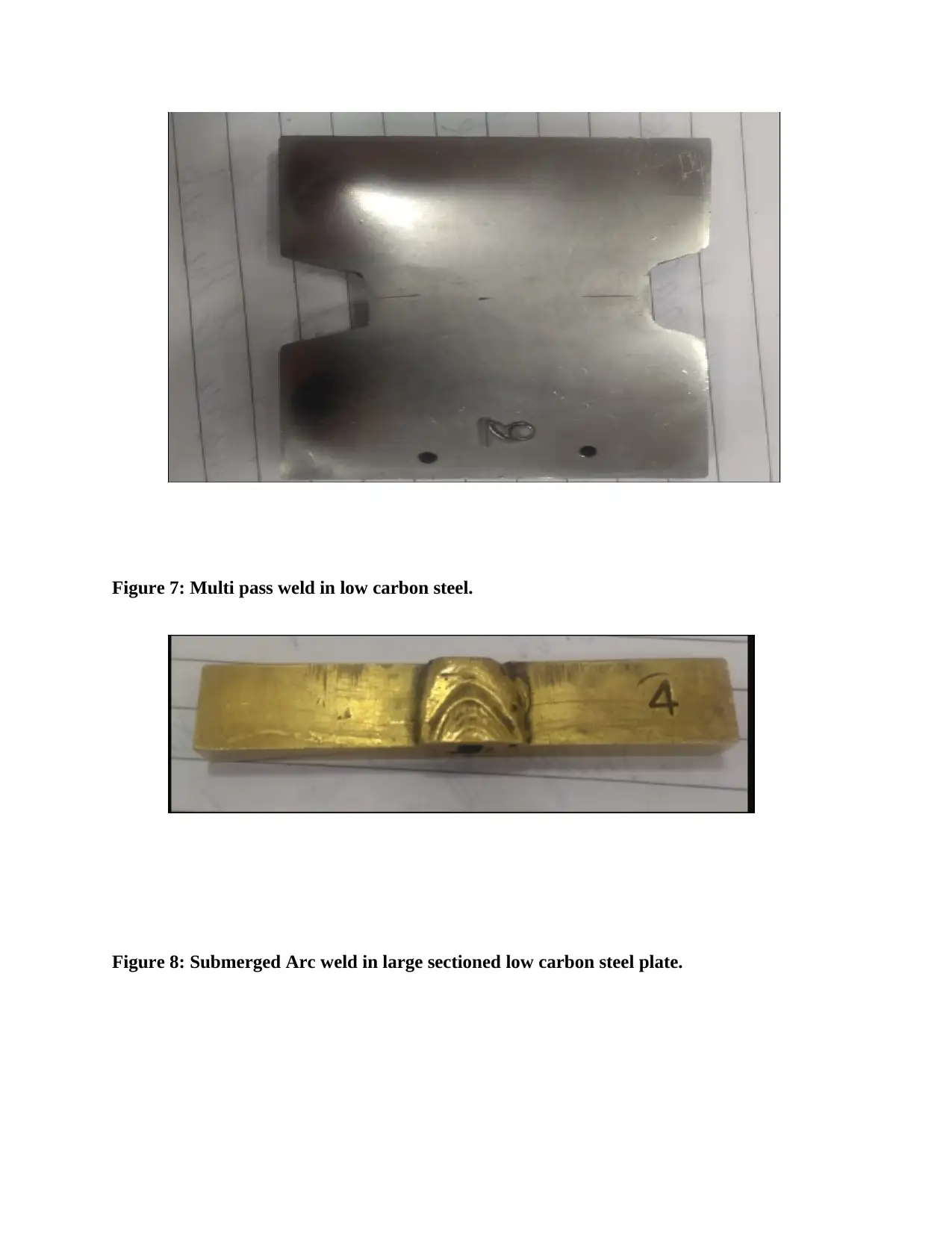
Figure 7: Multi pass weld in low carbon steel.
Figure 8: Submerged Arc weld in large sectioned low carbon steel plate.
Figure 8: Submerged Arc weld in large sectioned low carbon steel plate.

Figure 9: Tee piece in low carbon steel
Figure 10: Friction weld in carbon steel
Part two
Identified Faulty in the welds
Figure 10: Friction weld in carbon steel
Part two
Identified Faulty in the welds
⊘ This is a preview!⊘
Do you want full access?
Subscribe today to unlock all pages.

Trusted by 1+ million students worldwide
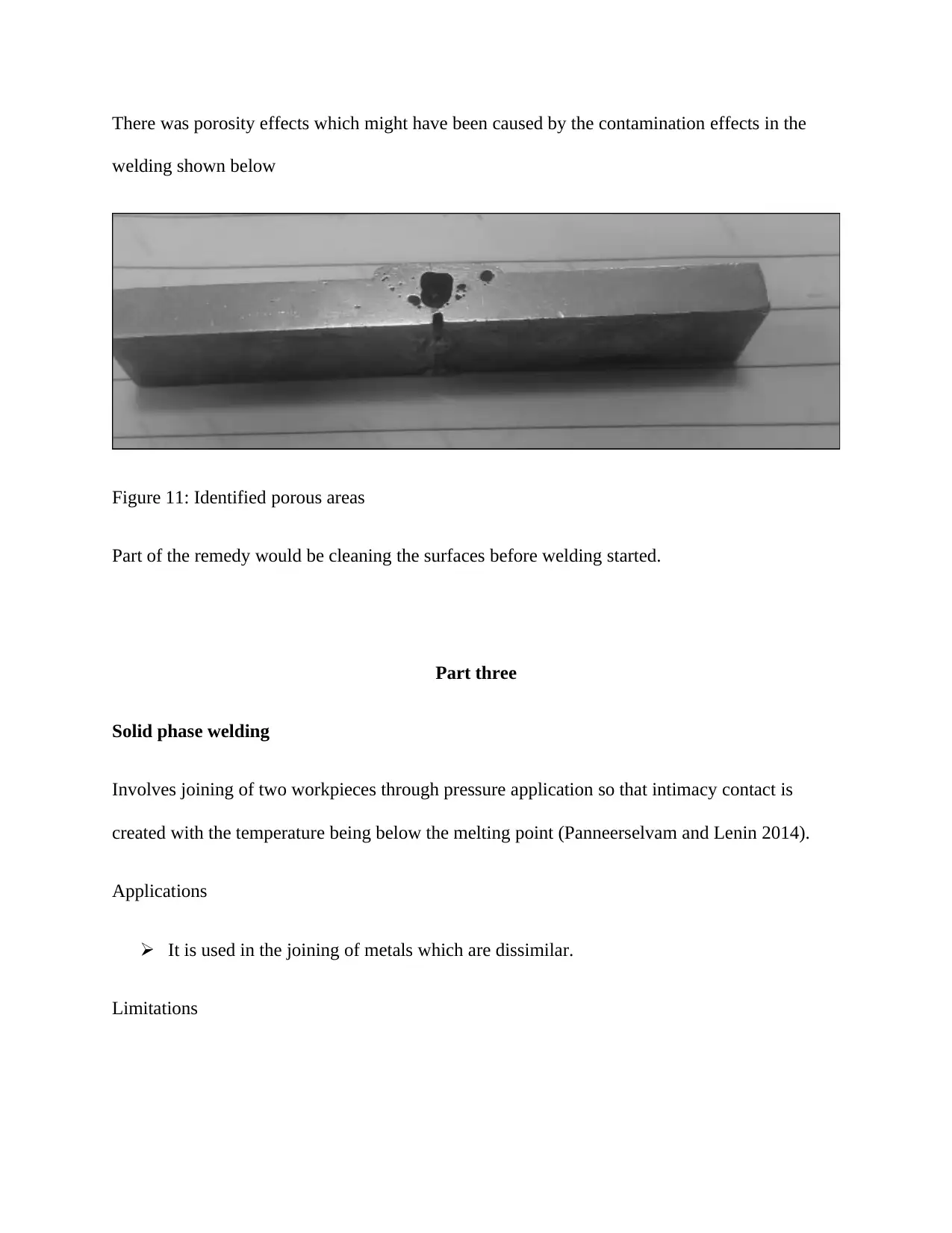
There was porosity effects which might have been caused by the contamination effects in the
welding shown below
Figure 11: Identified porous areas
Part of the remedy would be cleaning the surfaces before welding started.
Part three
Solid phase welding
Involves joining of two workpieces through pressure application so that intimacy contact is
created with the temperature being below the melting point (Panneerselvam and Lenin 2014).
Applications
It is used in the joining of metals which are dissimilar.
Limitations
welding shown below
Figure 11: Identified porous areas
Part of the remedy would be cleaning the surfaces before welding started.
Part three
Solid phase welding
Involves joining of two workpieces through pressure application so that intimacy contact is
created with the temperature being below the melting point (Panneerselvam and Lenin 2014).
Applications
It is used in the joining of metals which are dissimilar.
Limitations
Paraphrase This Document
Need a fresh take? Get an instant paraphrase of this document with our AI Paraphraser

Non-fusion
Parts are joined by the use of alloy with lower melting points than the metals to be fused.
Applications
Applied in cases where the mechanical properties of the metals are to be preserved (Neto
and Neto 2013).
Limitations
Strength of the weld is compromised because the weld material may not be effectively
adhesive.
Fusion welding: It involves joining of the metals with molten state of weld filler.
Applications
- In places where large spaces are to be filled.
- Applies to any shape i.e. no external pressure
- Easier welding
Limitations
Difficult in joining dissimilar metals
Intense heat affects properties of metals mechanically
Parts are joined by the use of alloy with lower melting points than the metals to be fused.
Applications
Applied in cases where the mechanical properties of the metals are to be preserved (Neto
and Neto 2013).
Limitations
Strength of the weld is compromised because the weld material may not be effectively
adhesive.
Fusion welding: It involves joining of the metals with molten state of weld filler.
Applications
- In places where large spaces are to be filled.
- Applies to any shape i.e. no external pressure
- Easier welding
Limitations
Difficult in joining dissimilar metals
Intense heat affects properties of metals mechanically
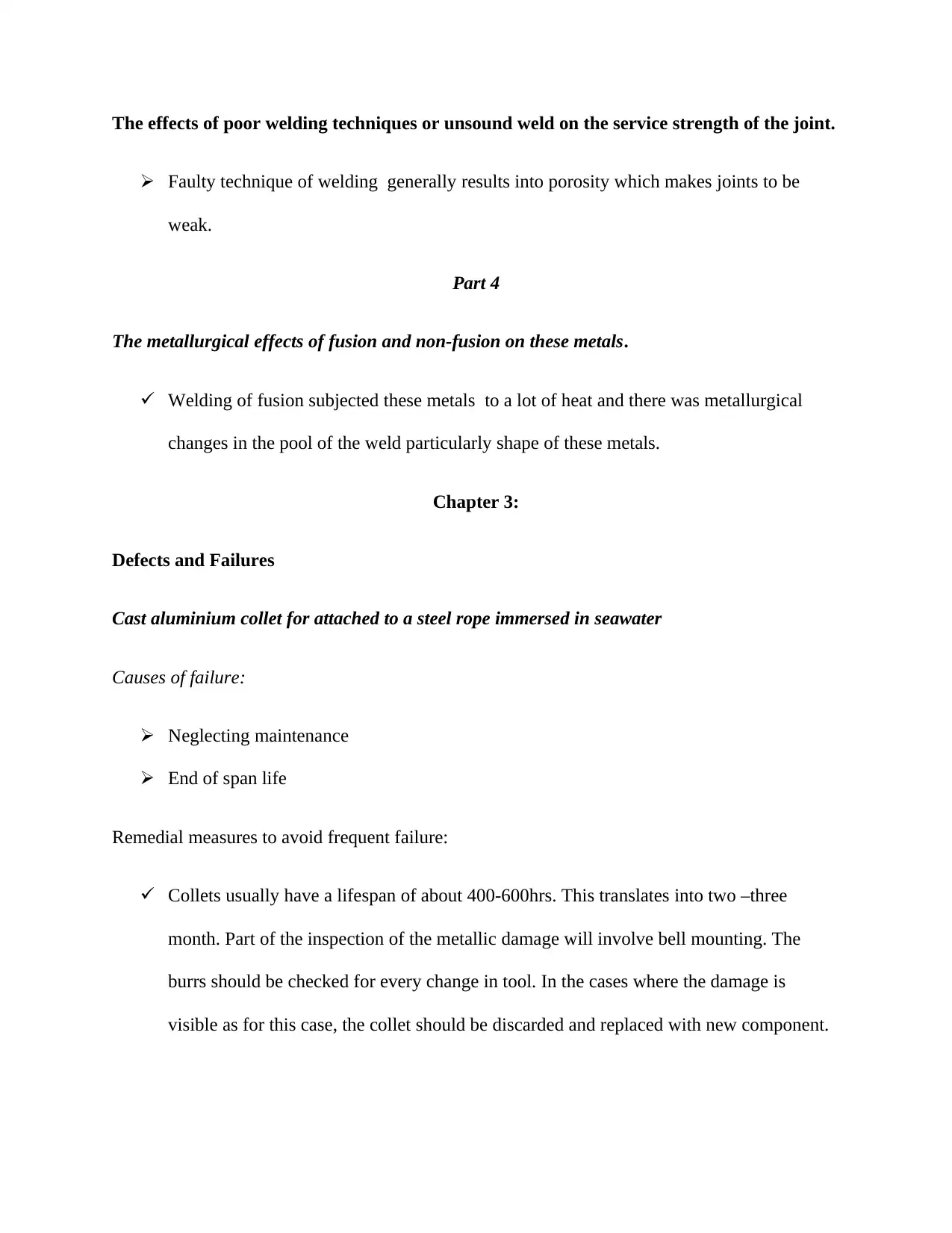
The effects of poor welding techniques or unsound weld on the service strength of the joint.
Faulty technique of welding generally results into porosity which makes joints to be
weak.
Part 4
The metallurgical effects of fusion and non-fusion on these metals.
Welding of fusion subjected these metals to a lot of heat and there was metallurgical
changes in the pool of the weld particularly shape of these metals.
Chapter 3:
Defects and Failures
Cast aluminium collet for attached to a steel rope immersed in seawater
Causes of failure:
Neglecting maintenance
End of span life
Remedial measures to avoid frequent failure:
Collets usually have a lifespan of about 400-600hrs. This translates into two –three
month. Part of the inspection of the metallic damage will involve bell mounting. The
burrs should be checked for every change in tool. In the cases where the damage is
visible as for this case, the collet should be discarded and replaced with new component.
Faulty technique of welding generally results into porosity which makes joints to be
weak.
Part 4
The metallurgical effects of fusion and non-fusion on these metals.
Welding of fusion subjected these metals to a lot of heat and there was metallurgical
changes in the pool of the weld particularly shape of these metals.
Chapter 3:
Defects and Failures
Cast aluminium collet for attached to a steel rope immersed in seawater
Causes of failure:
Neglecting maintenance
End of span life
Remedial measures to avoid frequent failure:
Collets usually have a lifespan of about 400-600hrs. This translates into two –three
month. Part of the inspection of the metallic damage will involve bell mounting. The
burrs should be checked for every change in tool. In the cases where the damage is
visible as for this case, the collet should be discarded and replaced with new component.
⊘ This is a preview!⊘
Do you want full access?
Subscribe today to unlock all pages.

Trusted by 1+ million students worldwide
1 out of 29
Related Documents
Your All-in-One AI-Powered Toolkit for Academic Success.
+13062052269
info@desklib.com
Available 24*7 on WhatsApp / Email
![[object Object]](/_next/static/media/star-bottom.7253800d.svg)
Unlock your academic potential
Copyright © 2020–2025 A2Z Services. All Rights Reserved. Developed and managed by ZUCOL.





